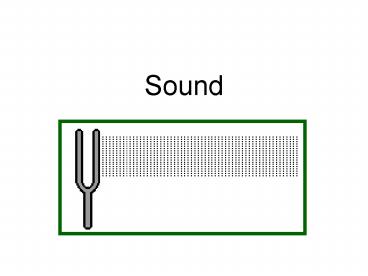Sound - PowerPoint PPT Presentation
1 / 16
Title:
Sound
Description:
Sound The Origin of Sound All sounds are produced by the vibrations of the material objects. Molecules MUST be present for there to be sound There is no sound in a ... – PowerPoint PPT presentation
Number of Views:38
Avg rating:3.0/5.0
Title: Sound
1
Sound
2
The Origin of Sound
- All sounds are produced by the vibrations of the
material objects. - Molecules MUST be present for there to be sound
- There is no sound in a vacuum b/c there are
almost no molecules
3
A Sound Wave
- Sound waves are longitudinal waves.
- Parts of a sound wave
- Compression areas of high pressure
- Rarefaction areas of low pressure
- As a source vibrates in a periodic fashion, a
series of compressions and rarefactions is
produced - For all wave motion, it is not the medium that
travels across the room, but the energy that
travels.
4
Pitch
- Pitch term that refers to how high or how low
sound frequencies appear to be - high frequency high pitch
- low frequency low pitch
- Ex Males have a lower pitch, females have a
higher pitch - A higher frequency results in a smaller
wavelength of the sound wave - Frequency and wavelength are inversely
proportional
5
Check Your Understanding
- Which as a higher pitch, a 440 Hz tuning fork or
a 330 Hz tuning fork? - The 440 Hz tuning fork b/c it has a higher
frequency - Which has a larger wavelength?
- The 330 Hz tuning fork b/c it has a lower
frequency.
6
Media that Transmit Sound
- Medium the surrounding environment
- Media is plural for medium
- A medium is whatever a wave is moving through
- Ex air in a classroom, water in the ocean
- Most sounds we hear are transmitted through the
medium of air. - Solids and liquids are generally good conductors
of soundmuch better than air.
7
- The speed of sound varies in different media. In
general, sound is transmitted faster in liquids
than in gases, and still faster in solids. - Remember that sound DOES NOT travel through a
vacuum
8
The Speed of Sound
- Sound travels much slower than light.
- The speed of sound in dry air at 0C is 330 m/s.
- The speed of sound at room temperature is 340
m/s. This is the accepted value of the speed of
sound. - The speed of sound depends on
- The type of medium (SgtLgtG)
- The temperature of the medium
- Elasticity of the medium
9
Check Your Understanding
- Will sound travel faster in steel or silly putty?
- It will travel faster in steel because steel is
more elastic than silly putty. - Will sound travel faster in outer space or in
water? - In water. As outer space is a vacuum, sound
cannot travel without the use of molecule.
10
Energy thru different media
- Remember that waves move energy, not matter
- This is true for sound waves
- When a sound wave changes its speed going thru
different media, it also changes its KE - A sound wave loses KE in air compared to water
b/c it slows down - A sound wave gains KE in a solid compared to
water b/c it speeds up
11
- Any KE change results in a change in another form
of energy - Remember conservation of energy
- Ex heat, PE
- If a sound wave looses KE, then some of that KE
may be converted to heat
12
Check Your Understanding
- When will a sound wave have the most KE, in the
ocean or in a steel bridge? - In a steel bridge. It can travel the fastest in
an elastic solid, so it will have the greatest KE - When will a sound wave have no KE?
- In a vacuum, like in outer space, because there
is no sound in space so there is no KE
13
Check Your Understanding
- Will sound have more KE in a warmer or cooler
room? - In a warmer room. Molecules move faster as the
temperature increases, causing the sound to move
faster, which leads to more KE.
14
Loudness
- Intensity the amount of energy transported
through a given area per unit of time. - Amplitude and intensity are directly
proportional. The louder the sound, the larger
the amplitude. - SI unit decibels (dB)
- Ex Mr. Ellwood has a high intensity to his
voice, Mr. Alexander has a low intensity to his
voice.
15
Interference of Sound Waves
- Constructive Interference ? crests (compressions)
overlap - Bigger amplitude
- louder sound.
- Destructive Interference ? crests (compressions)
overlap with troughs (rarefactions) - Smaller amplitude
- Quieter sound
16
Check Your Understanding
- A megaphone will use what type of interference?
- Constructive interference b/c megaphones increase
volume, which is an increase in amplitude - What type of interference is used in ear phone
air traffic controllers wear to cancel out all
sound? - Destructive interference b/c a decrease in volume
to zero, which is a zero amplitude































